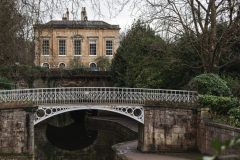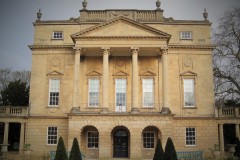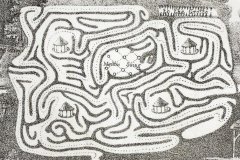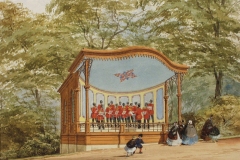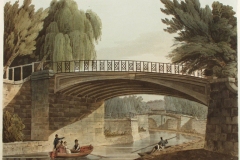A group of masons’ marks from a canal tunnel in Bath.
Kennet and Avon canal tunnel, under Cleveland House and Sydney Road, Bath, access via Sydney Gardens.
Sydney Gardens were laid out as commercial pleasure grounds between 1792 and 1794, as part of Robert Adam’s grand plan of ‘Bath new Town’. The initial detailed design was by Thomas Baldwin, who replaced Adam, and after he went bankrupt by Charles Harcourt Masters. The grounds were opened on 11 May 1795 as Sydney Gardens Vauxhall, and rapidly became a popular place of entertainment, hosting public breakfasts, promenades and galas. Jane Austen even mentions it in her letters to her sister: ‘…It would be very pleasant to be near Sydney Gardens; we might go into the labyrinth every day’. Jane Austen to Cassandra Wednesday, January 21, 1801.
The main building was the Sydney Tavern (now the Holburne of Menstrie Museum), which stood at the western end of the central walk, and housed tea and card rooms, a ballroom, coffee room and a public house. The gardens are now grade II listed and are the only remaining 18th century pleasure (or “Vauxhall”) gardens in the country.
In 1799, a section of the Kennet and Avon Canal (authorised 1794, opened 1810) was cut through Sydney Gardens. This, despite initial objections, added to the picturesque appeal of the pleasure grounds. In 1795 the canal company agreed to pay the huge sum of £2,100 plus the cost of providing the decorative bridges and tunnels insisted upon by the proprietors of Sydney Gardens as compensation. The northern (garden facing) opening of the 54 metre tunnel taking the canal under Sydney Road was dressed in a rusticated style (the southern end was left plain) and decorated with a classical theme, comprising niches set under recessed panels with swags and a large, raised ashlar panel with a central mask of a female head (inexplicably) representing Sabrina, the spirit of the Severn. In 1817-20 the canal company built their offices above and to one side of the tunnel in a classically styled Bath stone building designed by John Pinch. This building remained the offices of the Canal company until 1864, and was originally called Canal House.
An extremely wet walk along the towpath from Sydney gardens to Bath deep lock took in the tunnel, and revealed a fine selection of mason’s marks, including a variety of saltire designs, both on the stones within and featured prominently on voussoirs of the main arch on the decorated, garden-facing side.
All of the marks are deeply and carefully cut and internally form a matrix of tiny designs across and along the span of the tunnel. While clear masons’ marks are a regular find on ashlar construction blocks, the quantity and the prominence of the display is quite unusual, and must surely have been intentional. Were they displayed to publicise the work of the masons, or as a salute to the playful nature of the adjacent pleasure grounds? Were they placed around the arch and through the tunnel in the spirit of the then popular Gothic novels – so many of which included arcane symbolism and mysterious underground tunnels in their narrative? Or, finally, were they somehow felt to form a protective mesh to filter the ill effects of the pleasure grounds on the tunnel? It is all food for thought.
Post by: Rebecca Ireland
Mason’s marks, saltires
Kennet and Avon Canal, access via Sydney Gardens, tunnel is under Sydney Road.


